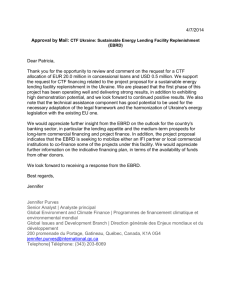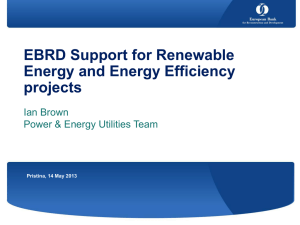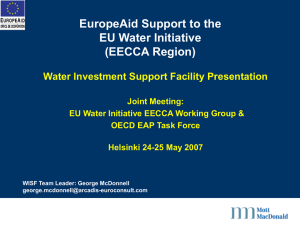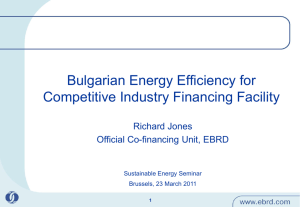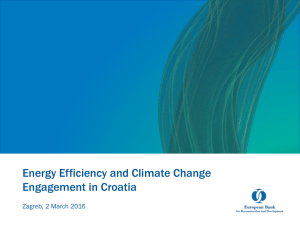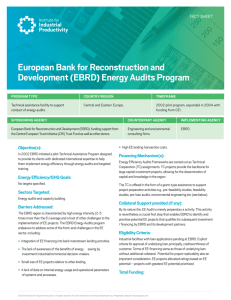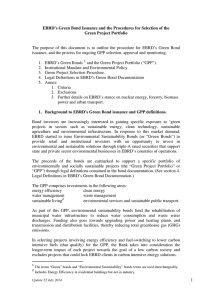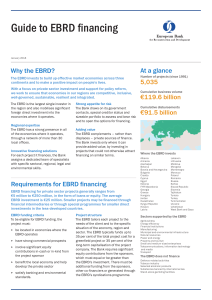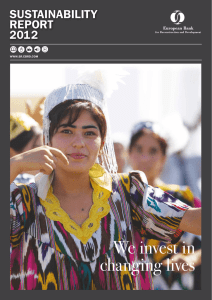EBRD and Financing of Aviation Transport Projects
advertisement
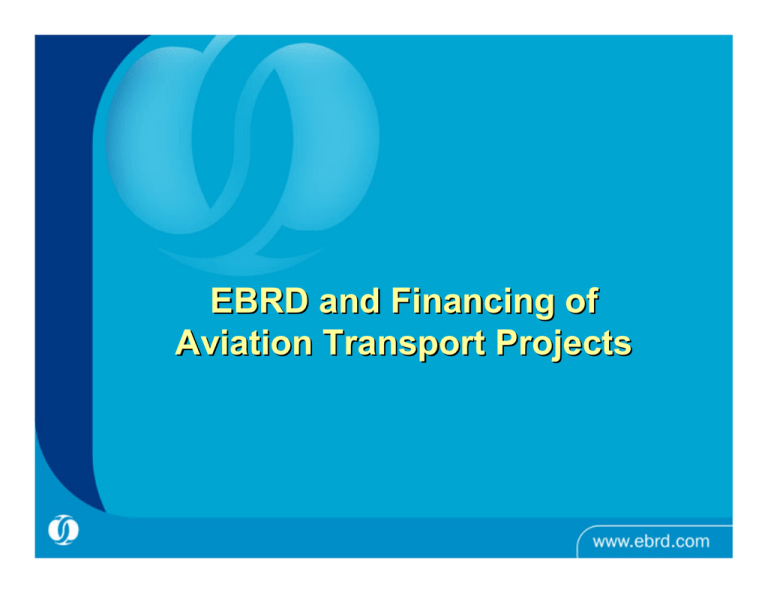
EBRD and Financing of Aviation Transport Projects EBRD and the Transport sector z What makes EBRD different from other IFI’s? z Overview of Transport business z Transport Portfolio z Business Opportunities in the Transport sector z Transport Pipeline z Key Challenges 1. What makes EBRD different to other IFIs? z Unique mandate - both political and economic to promote transition to market-based economies by investing mainly in the private sector z Main objective is to mobilise significant foreign direct investment and support privatisation, restructuring and better services to improve people’s lives z To encourage environmentally sound and sustainable development z Focus on developing financing solutions which meet the client’s needs z Invests primarily in private sector projects IFI with investment banking skills z Specialised knowledge of central and eastern Europe and the CIS and the largest investor in most of its countries of operation z Extensive offer of financial products z Dedicated teams with expertise in a variety of sectors and countries combining investment and commercial banking expertise with local knowledge and contacts z In-house understanding of legal framework for both debt and equity financing Financial flexibility z Wide range of Loans (fixed, floating, choice of currency) z Equity, including combination of loan and equity z Guarantees, including credit enhancements (performance bonds etc.) z SME loans, Equity funds, Micro/small business programmes, Credit lines, Cofinancing z Tailored to meet projectspecific needs including repayment schedules and specific situation of country/region and sector z Innovative products/structures z Pricing reflects risks with project, borrower and country EBRD risk profile Sponsors EBRD z Takes financial risks z Takes political risks z Takes long maturity z Shares equity risk z Expertise and sound management z Take operational, market and construction risks EBDR applies sound banking principles. All projects must be economically and financially viable. Risk sharing to achieve debt capacity maximisation and risk compartmentalisation 2. Overview of Transport Business Roads Construction of Highways, operation and maintenance, toll roads, road haulage... Maritime Port infrastructure (berth, breakwater) superstructure, shipping, stevedoring... Railways Railway infrastructure, Freight, Passenger rail, inter-modal transport... Aviation Airport development, aircraft leasing, air cargo, air traffic control systems... 3. Transport Portfolio (I) By sector Ports - 6 projects 4% Railways - 23 projects 37% Aviation 21 projects 8% Roads - 26 projects 51% Total portfolio of EUR 2.3bn with 76 projects 3. Transport Portfolio (II) By region Central Europe - 29 projects 32% Central Asia – 15 projects 19% Russia - 5 projects 22% SEEC - 27 projects 26% Total operation cost of EUR 8.7 bn with 76 projects Selected Air Transport projects AS ASTallin TallinAirport Airport Estonia Estonia Ministry MinistryofofTransport Transport and andCommunications Communications FYR FYRMacedonia Macedonia The TheRussian RussianFederation Federation Globeground, Globeground, State Aviation State AviationEnterprise Enterprise Pulkovo, Pulkovo,LenStroiGilService LenStroiGilService) ) Tallinn TallinnAirport AirportLoan Loan EUR €7.5 EUR €7.5million million Civil CivilAviation Aviation Upgrading UpgradingProject Project EUR €15.6 million EUR €15.6 million October October2002 2002 July July2002 2002 Air AirCargo CargoTerminal Terminal Pulkovo Pulkovo EUR EUR€12 €12million million Modernisation Modernisationofof Macedonian MacedonianAir AirNavigation Navigation Services Services Construction Constructionand andoperation operation ofofAir Cargo Terminal Air Cargo Terminalinin St. St.Petersburg Petersburg- -Phase PhaseI I Construction Constructionand andCorporate Corporate loan for the Refinancing loan for the Refinancingofof the theInternational InternationalAirport Airportofof Tallin-Estonia Tallin-Estonia October October2000 2000 4. Business opportunities in the Air Transport sector z Aviation: Air Navigation Systems and airport infrastructure development z Opportunities for private sector in construction of airport terminals and airport privatisation (runway, taxiway improvements, ground handling equipment, passenger and cargo terminal buildings) Private sector participation z Privatisation: Opportunities for new investments or for the rehabilitation of existing facilities to be developed by the private sector in the form of: Concession: full concession granted by the State to a fully private or private majority ownership company Commercial Agreement Public Administration managing the State assets, and private entity for rehabilitation and operation of assets Contractual Agreement Private operator under contract (e.g. Management or operating contract) and State finances investment requirements Public-Private partnership z Government and private sector work together, sharing investment, risk, responsibility and reward. EBRD can provide debt to the Host Government to finance the cost of its own contributions to the PPP and finance to the Project Company – Private Sector driving force of project through financial, management and technical support. – Public Sector provides key project assets (i.e. infrastructure) and establishes legal and contractual framework as well as supporting project development in medium-long term Leasing opportunities z Leasing is an important financing tool for capital equipment providing vendors with a different sales tool in higher risk countries z Vendor finance facilities financing to medium size companies for acquisition of modern equipment z Financing of more broadly based aircraft leasing companies z Assess and share credit risks of equipment lessors in our countries of operation z EBRD has substantial expertise and fast growing leasing portfolio 5. Transport Pipeline (I) By sector Aviation 7 projects 18% Ports - 8 projects 14% Railways – 13 projects 24% Roads - 10 projects 44% Total pipeline of EUR 1.8 bn with 38 projects Key challenges z Public affordability and Political acceptability: Financial planning and state budget constraints z Creditworthiness (if relevant) – revenue generation below potential – political and social constraints to economic pricing – budget deficit and vast investment needs – credit rating z Legal and regulatory uncertainty z Extent of private sector participation z Realistic traffic projections z Financing opportunities post 2004 in Accession countries 6. Information and contacts at the EBRD Riccardo Puliti Director, Transport Tel: +44 207 338 7379 e-mail: pulitir@ebrd.com Florence Bachelard-Bakal Aerospace coordinator, Transport Team Tel: +44 207 338 7014 bachelaf@ebrd.com www.ebrd.com
